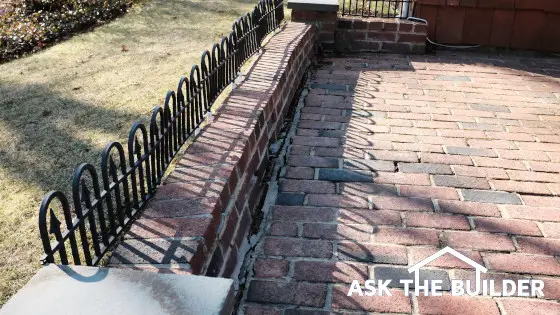Retaining Walls – Not So Simple

This is a tiny retaining wall and it failed. It’s leaning and the homeowner is none too happy! (C) Copyright 2020 Tim Carter
This column appeared in the February 29, 2020 edition of Tim's newsletter.
DEAR TIM: I want to build a retaining wall that’s going to look great for years. At my last house, I had a short retaining wall around a patio that started to lean out towards the lawn. The little wall was but 10 inches tall for goodness sake with no soil pressure against it. Why do you think that wall failed and what can I do to build retaining walls even three feet tall that will not tip over? Jonathan H., Melville, NY
It’s hard for me to fathom a short tiny retaining wall like that failing, but by gosh you can see it in the photo Jonathan sent me. Sure enough the tiny wall is leaning about three inches back towards his lawn.
There are two thoughts that come into my head as to why his tiny wall failed. I surmise the footing that’s under the wall is missing or a very bad design. I’ve seen very narrow thin footings under failed walls like his.
Jonathan’s wall is but 8 inches wide. I would have installed a footing that was no less than 6 inches thick with two number 5 steel rods in it continuous along the length of the footing. I would have made the footing 24 inches wide so it would be three times as wide as the wall itself. This allows fill dirt to be on top of 2/3rds of the footing. This weight helps offset tipping forces.
Jonathan also lives where the ground freezes. Frost heave could have easily tipped this wall over a little bit each year. Jonathan’s photo has a very important clue in it. The water from the patio-side of the wall has to drain somewhere and it appears it goes into the soil along a wide crack between the patio and the wall.
This water can be super-charging the soil under the house side of the wall. Frost heaving can be greater on that side of the wall because of this water concentration. Water freezing in the crack between the wall and the patio can also slowly start to tilt the wall away from the patio.
Retaining walls are not as simple to design as you might think. This is why structural and civil engineers are math experts. An interesting thing happens as a retaining wall gains height. Doubling the height of a retaining wall doesn’t mean the tipping forces behind it double. They increase in a non-linear fashion. The tipping forces on a wall of a given height can be three to four times what they are on the same wall half as high!
A three or four-foot high retaining wall can have tipping forces measured in the hundreds of pounds and sometimes higher than one-thousand pounds if the ground above the wall is sloping up away from the wall. Gravity, one of Mother Nature’s tools, is very patient and persistent. It can start to tilt the wall away just a fraction of an inch per year, but over time these fractions add up to whole numbers.
Mass, or thickness, is your friend in almost all cases when designing and building a retaining wall. The thicker the wall is at its base the better. The wall can get thinner as the wall gains height.
Concrete block retaining walls need to be reinforced. This means reinforcing rods need to be installed that tie into the footing and these rods must be surrounded by a concrete grout in the hollow block cores. Any block wall taller than three feet should be designed by an engineer if you want it to last for decades.
Retaining walls can have a backwards lean to them. Think of the wall as you pushing your shoulder against a millstone. You lean into the millstone to give yourself more leverage. The lean doesn’t have to be drastic, but it can surely help ensure the wall looks fantastic for many years.
Drainage behind retaining walls is also very important. I always installed perforated drain tile behind my walls and made sure the pipe had an outlet to daylight so water would never build up behind the wall. I’d never directly backfill against the wall with soil. I’d always install a 6-inch-minimum layer of washed gravel behind the wall so water could flow down to the drain tile with minimal resistance.
Here’s another tip if you want your new retaining wall to look fantastic for as long as you live. Once the wall is built, but before you backfill against it, coat the back of the wall with two coats of some asphaltic water or damp-proofing foundation coating. This will prevent, in almost all cases, water from seeping into your wall.
Water seeping into the wall can carry dissolved salts from the soil, from salted parking lots above you, or even salt in the ground water itself. This salt solution will seep through the wall, the water will evaporate on the visible side of the wall, and you’ll be left with pesky efflorescence salt deposits on the front face of the wall.
Don’t underestimate the soil pressure behind retaining walls, especially those with a parking area above them. Not only do you have to contend with the pressure and weight of the soil, but when a heavy truck parks just two feet away from the back of the wall, you also have added weight pushing against the soil. GL as we say in Morse!
Column 1342
One Response to Retaining Walls – Not So Simple